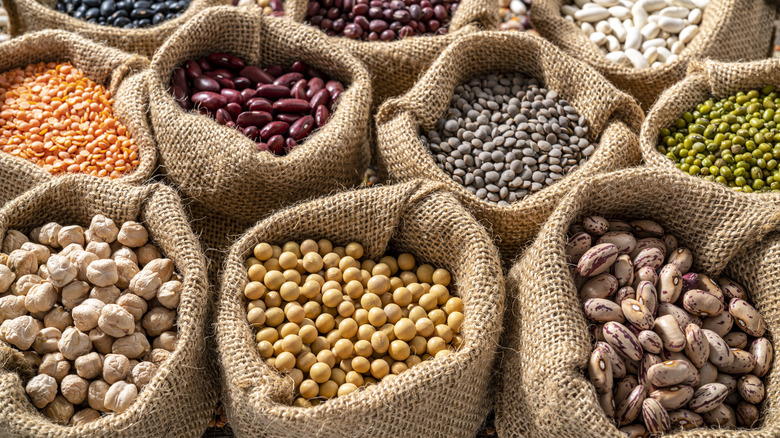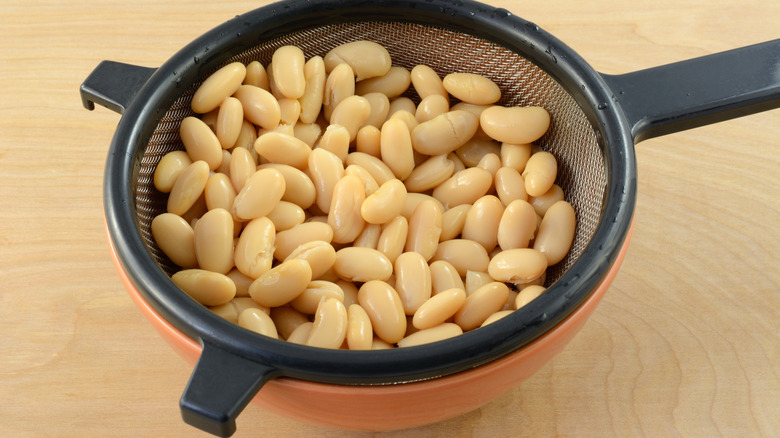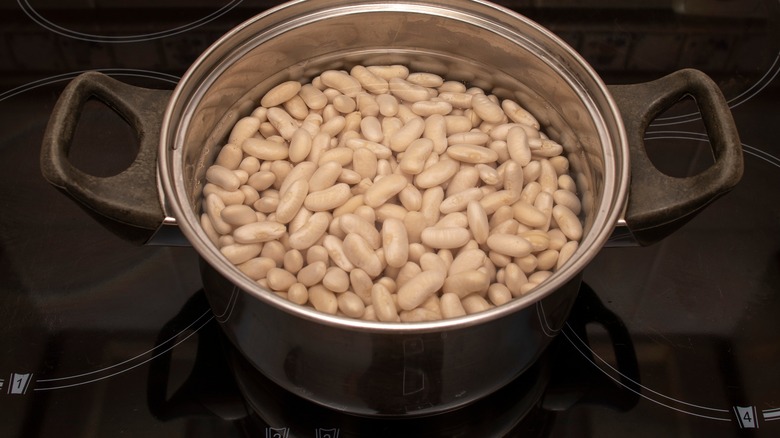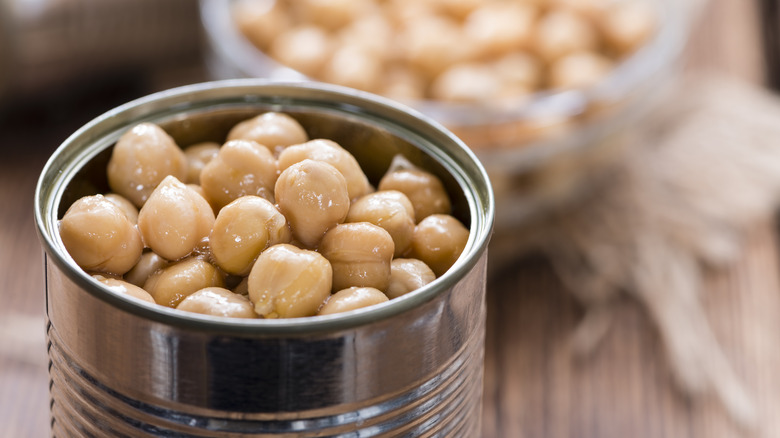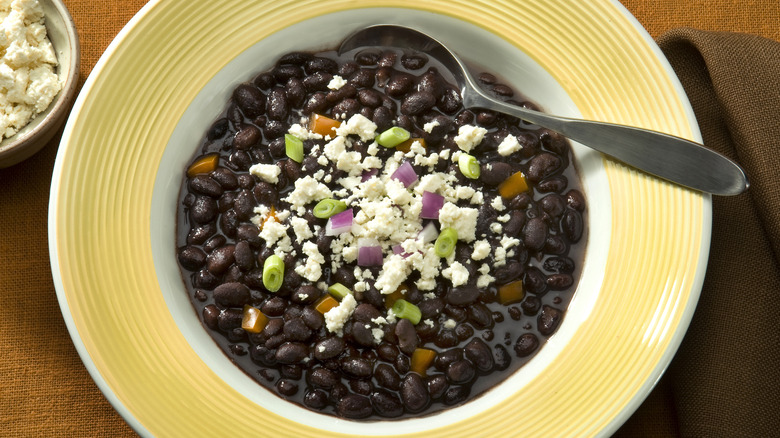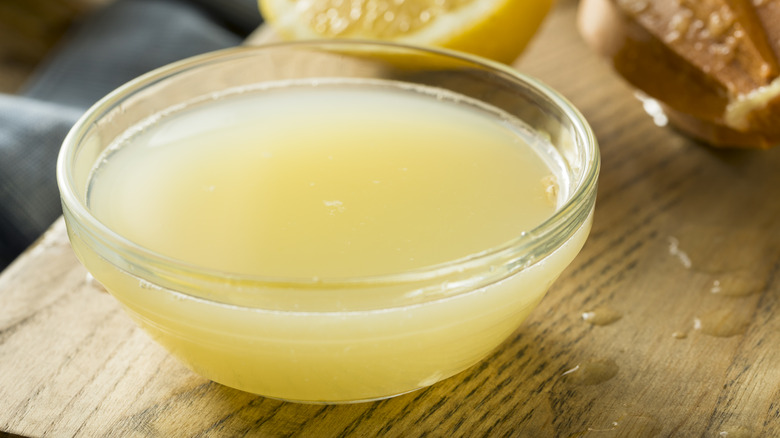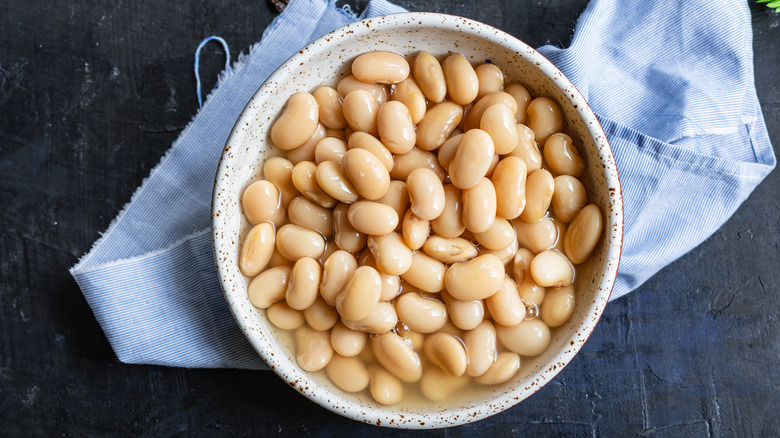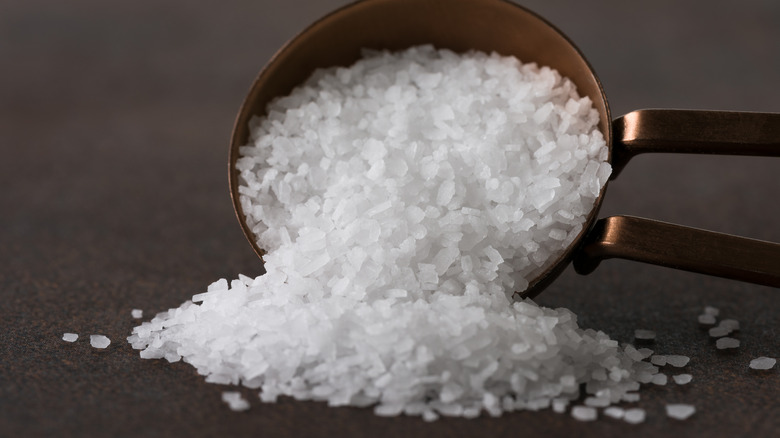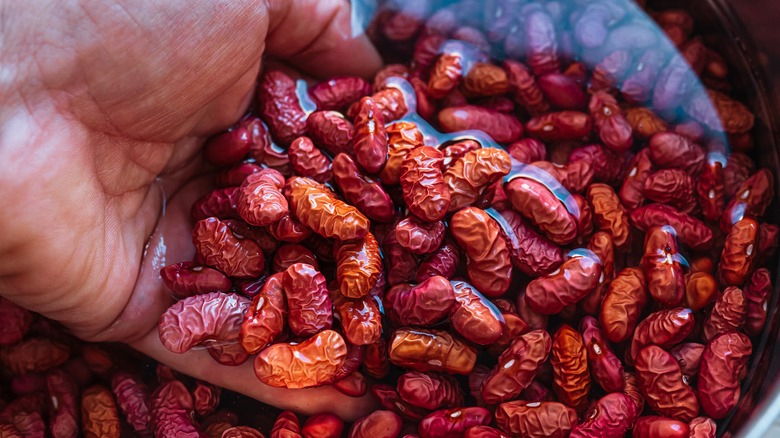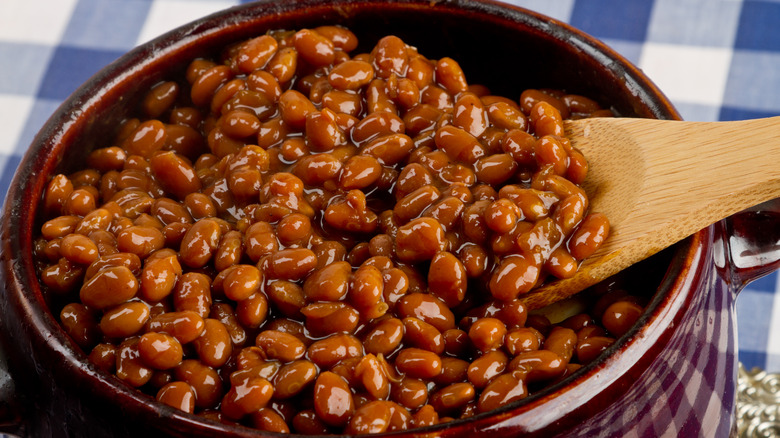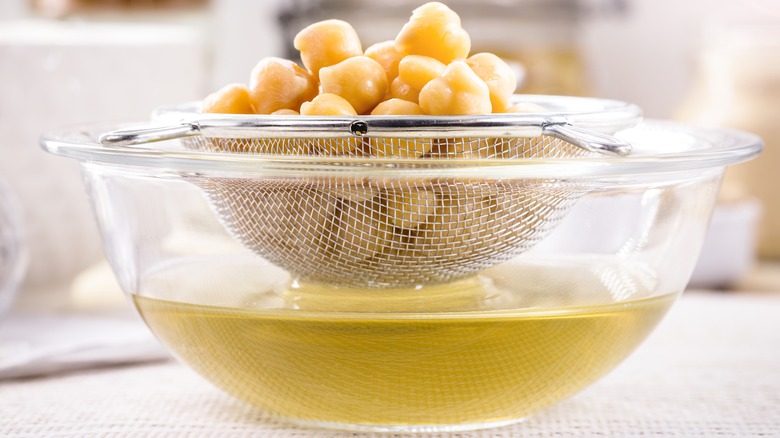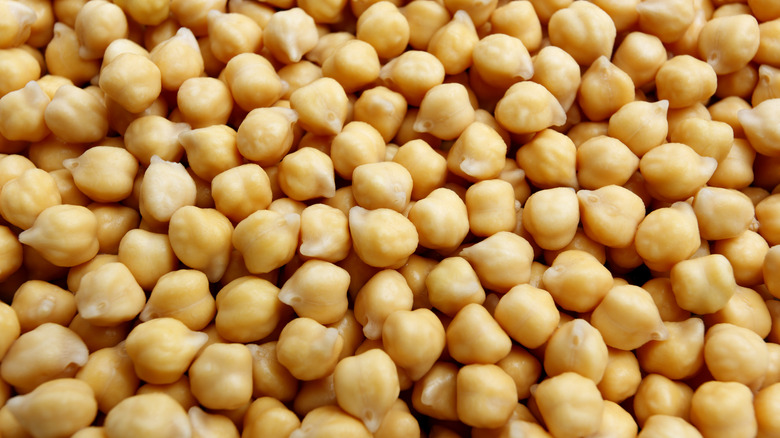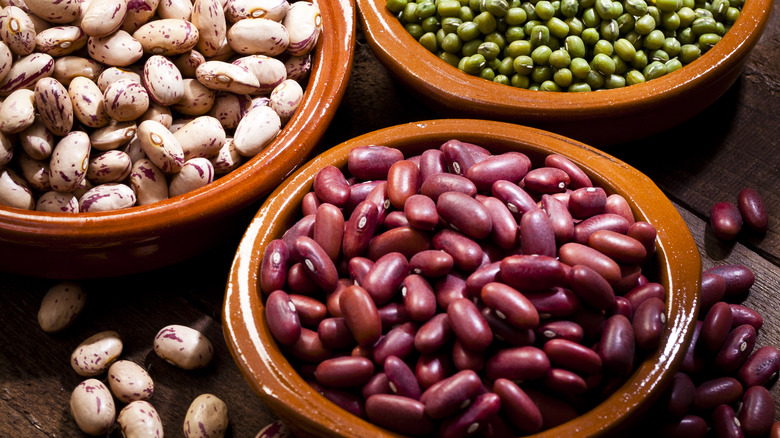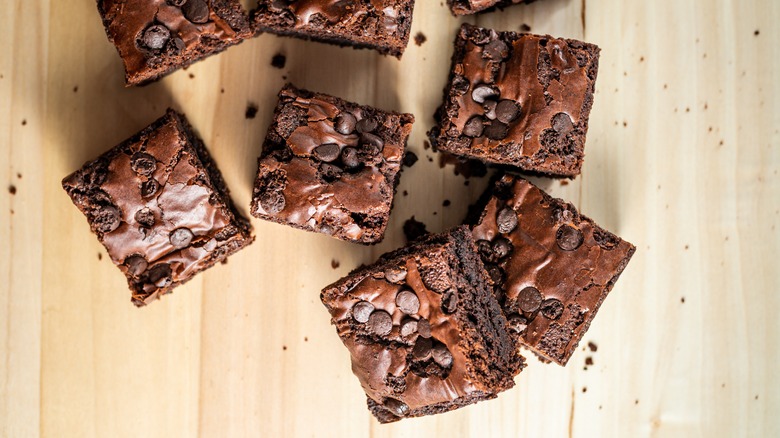13 Common Mistakes Everyone Makes When Cooking Beans
Cooking beans seems easy, but it can be more confusing than you think. These legumes, which come in all different shapes and sizes, are tender and soft when prepared correctly, but add the wrong thing to your pot or use the wrong kind of water, and they can quickly turn rock-hard. For newbies, too, dried beans can present a particular issue: The soaking process can be slightly more involved than you think, and if you're doing this wrong or using beans that aren't their best, it can end up ruining a core element of your meal.
This is particularly problematic, as when they're cooked correctly, these legumes can be a nutritious and versatile ingredient, providing a key protein and fiber source to a variety of bean dishes enjoyed around the world. That's all before their flavor, too, bringing nutty and creamy notes to your kitchen table, and yet certain cooking mistakes can completely ruin both their flavor and their moreish texture. Luckily, we've bean looking (see what we did there? Bean look— okay, yeah, you got it) at some of the key mistakes people make when they're cooking beans, and we've got some solutions for you.
Forgetting to rinse your canned beans
Canned beans are an ingredient you should always have on hand, thanks largely to their ease of preparation: You just need to open the can, and they're ready to go. Failing to rinse them in fresh water before using them, though, can affect the flavor of your meal, and how much they impact your post-dinner digestion. "[Rinsing] gives the bean a cleaner mouthfeel and prevents the gel-like coating from altering the flavors of the surrounding ingredients," explains the Institute of Culinary Education's Plant-Based Culinary Arts chef-instructor Richard LaMarita, via Simply Recipes. As your beans sit in their canning water, their soluble fiber leaks out into it, giving it a gloopy quality and a chalky taste — which ends up in your food.
This soluble fiber can also promote bloating and gas, says LaMarita, especially in folks who don't eat beans regularly or have a high fiber consumption. Rinsing your beans won't entirely negate the fiber's effect on your stomach, as legumes are fiber-rich already, but it can take the edge off. Rinsing your beans can also reduce any ingredients you might not want in your dish, like excess sodium, preservatives, or other flavorings in the can.
Not pre-soaking dried beans
Contrary to popular belief, it's entirely possible to cook dried beans without soaking them first. Just because you can, though, doesn't mean you should. Soaking dried beans ahead of time can reduce your overall cooking time, and while it may only do so by a matter of minutes, this short window could be the difference between a perfectly cooked dish where everything's in harmony, and a meal where certain ingredients are mushy and over-boiled.
That's not the main reason to soak beans, though. Doing so reduces their oligosaccharides, a type of carbohydrate and prebiotic that can cause excess gas production. Soaking dried beans causes most of the oligosaccharides in them to leach out into the soaking water. Adding a little baking soda to the water can help to do this even more effectively. Either way, when the water is disposed of, you'll end up with an altogether smoother dining experience. Beans also soften when they're soaked in hot water, which can then improve their texture once cooked, making them more tender. You can soak your beans for as little as an hour after bringing them to a boil in a pot of water. Just remember, though, that the longer you soak them, the more oligosaccharides you can remove.
Using beans with added sodium
Not all canned beans contain sodium, but when they do, they can have it in some pretty wild quantities. Bush's Best Navy Beans, for example, have 470 milligrams of sodium per half-cup, an amount that adds up to over a fifth of the daily value — and each can contains about 3½ of these servings. The problem with these high-sodium products is that aside from having a pretty big impact on your daily nutritional intake (especially for such a small amount of food), they can end up making your food taste briny and nearly inedible. It's very easy to pick up a can of beans without realizing it's full of sodium, and once you've put them in your meal and added a few pinches of salt, it's very hard to pull the flavor back.
The best thing to do is to be as careful as possible when buying beans. Get used to scrutinizing your nutritional labels, and opt for low-sodium options, which are thankfully very common in larger supermarkets. If you do accidentally pick up a can of salty beans, rinsing them with water can be helpful, but it's worth remembering that doing this will only get rid of about 40% of the sodium content, as some of it will have soaked into the beans themselves.
Thinking your beans are totally interchangeable
Most beans are fairly similar to one another, and in a pinch, you can swap one type out for another without too many issues. However, assuming that they're totally interchangeable is a big mistake. Beans have subtle but distinct flavor and texture profiles, as well as different visual appearances and sizes which make them individually suited to certain dishes.
You only have to look at the difference between black beans and butter beans to see proof of this. Black beans are firm and chewy, even when they're cooked well, and they have a nutty, earthy overtone that makes them a natural fit as a meat replacement. Their smaller size also makes them perfect for use in dishes where you need them to be noticeable but still maneuverable, like in nachos or tacos. Butter beans, on the other hand, are generally softer, and true to their name have a creamy, butter-like taste. Their chunkier dimensions and larger size make them a great fit for soups and stews, where you'll want them to hold their own, but less useful for hand-sized or finger food. Swapping one for the other won't ruin your meal by any means, but it will alter it.
Cooking beans in acid
Beans are full of cellulose, and when cooked correctly, their structure tends to break down, with the beans splitting open and revealing their soft, tender insides. Adding acid into the mix, however, can totally prevent this. Altering the pH level of the environment that your beans are cooking in, and reducing it by adding acid, can cause each bean's cell structure to stay firm. Softening them by cooking them down will take way longer than normal, and you then run the risk of overcooking every other element of your meal.
The easiest and quickest solution to this problem is to try and maintain an alkaline environment for your beans for as long as possible. Putting a pinch of baking soda into your meal will help your beans break down quickly, saving you a lot of cooking time. If you're making something with acidic ingredients, you should always cook your beans first, and then add the other ingredients towards the end. Take particular care when cooking beans in tomato-based sauces, as these fruits are pretty acidic. It may also be a good idea to cook the two items separately and combine them at the end.
Boiling them too rapidly
Trying to speed up your meal's cooking time by turning up the heat can feel logical, but when you're cooking beans, this can ruin their texture. Beans are surprisingly delicate, and when their skin splits, their starchy insides can begin to leak out into your food. Not only does this ruin the integrity of your beans themselves, preventing each bite from being satisfying, but this starch can have an inadvertent thickening effect on your cooking liquid, resulting in things becoming gloopy.
All of this can happen if you're boiling your beans too rapidly, which makes them overcooked on the outside but also leaves them undercooked on the inside. This is due to the higher heat, of course, but also the increased motion from when your food is boiled vigorously, allowing the heat to get around the beans more easily. Instead, you should keep in mind that beans are best cooked low and slow. Doing so will let them cook consistently, and keep them creamy but with a gentle resistance on their outsides.
Forgetting to salt your dried beans
Cooking beans can be a delicate balance. Add too much salt, and they can end up unpleasant-tasting and brackish. Add salt at the wrong time, meanwhile, and its flavor doesn't permeate through to the beans' insides. Alternatively, you can end up not adding enough salt at all, leaving you with bland, boring beans.
You can avoid all of these things by salting them while you soak. When you add your dried beans to their soaking water, pop in a tablespoon or two of salt, suggests Joe Yonan, author of "Cool Beans," via Food & Wine. Doing this essentially creates a brine, and as with any other brined food, the salt then soaks into the beans, flavoring them on the inside. As well as this, the salt helps to soften them up, which then makes them more biteable and tender when cooked.
It's important not to oversalt your brining water, as the more you add, the saltier your beans will be. As well as this, remember that your beans will take a significant amount of sodium with them to the pot, so ease off on the salt later in the meal.
Using hard water to soak your beans
Soaking your beans is a great way to soften them, but using hard water to do it may have the opposite effect. The reason hard water is considered "hard" is because it's mineral-rich, containing calcium and magnesium. This calcium interacts with your beans negatively when they're soaked in hot water, affecting the pectin in their cell membranes and preventing it from loosening, which would usually cause your beans to soften when heated. As a result, your beans stay hard, no matter how long you soak them, and will remain so when you're cooking them.
If possible, you should try to soak your beans in soft water. The most thorough way of doing this is by using a water softener, water softening tablets, or a filtration system. You can also soak your beans in bottled water, although we would point out that this can be a pretty pricey way of preparing your food. It's useful to remember that chlorinated water can have a similar effect on beans, and also stop them from softening. Luckily, boiling water for at least 15 minutes can effectively remove chlorine from it, so if in doubt, get your pot of water on the stove and turn up the heat.
Undercooking your beans
Using dried beans instead of canned ones can give your meal a rustic feel, and allow you to better control the consistency of your legumes. However, it also makes it way more likely that you'll undercook them. Importantly, doing this won't just result in your beans being chalky and hard. Undercooked beans can be dangerous, with raw and undercooked kidney beans containing a natural protein called lectin that's destroyed by cooking them at adequate temperatures for long enough. In high enough amounts, lectin can act as a toxin, and produce food poisoning symptoms like vomiting and diarrhea (per Food Safety News).
This can be avoided by soaking your dried beans thoroughly before use and cooking them for a good amount of time, but it can also be avoided by steering clear of your slow cooker. Slow cookers may not get to a high enough temperature to adequately remove all the lectin in dried kidney beans, so meals prepared in them can still pose a risk. If you are using a slow cooker recipe, it's advisable to use canned kidney beans for it — and it may be a good idea to stick to canned beans anyway if you're concerned about food poisoning.
Throwing away your aquafaba
Aquafaba is the name for the liquid your canned beans have been preserved in, but when most people refer to it, they're specifically talking about chickpea water. This chickpea water is all too often drained away when people are preparing their meals, and when that occurs, they're draining away a lot of culinary potential. Aquafaba is full of starch, and this acts as a binder, allowing the liquid to incorporate plenty of air when whipped. This means that when it's whisked, it puffs up and turns into a perfect vegan substitute for egg whites in a classic French meringue.
The fluffy, foamy aquafaba solution can also be added to a host of other baked goods, like cookies and pancakes, instead of egg whites. When incorporated into recipes that use chocolate, vanilla, or other bold flavors, aquafaba will be virtually indistinguishable from egg whites and have none of the chickpea taste you might expect. In the fridge, aquafaba can last for up to five days, but it can last significantly longer in the freezer. It can be a good idea to separate it into individual portions when freezing it, so you don't have to thaw it all in one go.
Swapping dried beans for canned ones in recipes
The question of whether canned beans can be substituted with dried ones comes up a lot, and to new chefs, the answer can feel like a pretty obvious "yes." Importantly, though, doing so may not give you the same result, either flavor-wise or quantity-wise. When you soak and cook dried beans, they swell up as they take on water, and generally double in size. As such, you need roughly half the amount of dried beans that you'd use in a recipe that calls for canned ones, or you'll end up with way too many in your food.
In terms of flavor, too, dried beans and canned beans can taste pretty different, especially if your canned beans have added ingredients or excessive sodium. The canning process itself can also change, and sometimes dull, the flavor of legumes. This is particularly obvious when it comes to chickpeas, which have a nuttier flavor when dried and therefore are vastly superior for making hummus and falafel. Dried chickpeas, and any dried beans, will also have a different texture to canned ones, so you may end up with a different mouthfeel for your food.
Cooking with old dried beans
Dried beans can stay edible for an incredibly long amount of time, and you can keep them in your pantry for a good few years and still pull them out when you need them. However, the longer you leave them, the more they'll deteriorate. "They were never meant to be timeless," says "Lunch At The Shop" author Peter Miller via Food52, refuting the myth that dried beans can last forever. The problem is that as your dried beans age, they begin to lose their creaminess and soft texture, which becomes evident once you soak them and find that they just don't turn tender. They also lose any fresh taste they once had and become dull.
It's best to use dried beans within any use-by date printed on its packaging, or if there is none, within a year of buying them. However, it's also good to use your common sense. If you soak your in-date beans and find that they're still tasteless and tough, throw them out and get some new ones. With that said, you may well find that older dried beans are still totally edible and delicious — the best thing to do is to pay attention.
Forgetting to use beans in sweet recipes
Beans are a staple ingredient in countless savory recipes, from Meditteranean beef and bean stew to cassoulet de Toulouse. You shouldn't forget, though, that they're just at home in sweet recipes too. Beans can provide a thick, creamy texture to desserts and a gently nutty taste that can help to highlight sweet notes. Additionally, they can give your after-dinner treats a very attractive boost of fiber, protein, and vitamins.
So, instead of making regular chocolate brownies, make black bean brownies instead. These brownies pull out some of the flour content and replace it with black beans, giving it a bulk and a thick consistency, as well as lending a deep-brown color to the dish. The black beans also give the brownies a natural chewiness which works perfectly for the fudgey dessert. Rather than make flour-heavy chocolate chunk mocha cookies, you can also make a flourless double chocolate mocha bean cookie recipe, again by using black beans as the main binder and throwing in cocoa and chocolate chips. White beans, meanwhile, can be used in place of flour in blondie or vanilla cookie recipes, while aquafaba can be added to a host of egg-free desserts.
